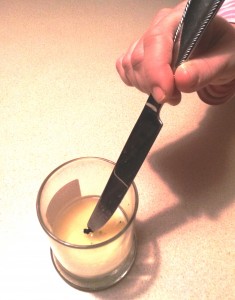 So you notice that jar candle up on the mantle has a pretty deep pool of melted wax and you think to yourself, “It’s time to blow that out.” But before you do, read on – as there’s a better way to go about it!
So you notice that jar candle up on the mantle has a pretty deep pool of melted wax and you think to yourself, “It’s time to blow that out.” But before you do, read on – as there’s a better way to go about it!
Not to get all science-y on you, but you’ve probably noticed that when you blow out a candle, it smokes – sometimes a lot. That’s because the core of the wick continues to burn for a short time. In that time, the inside of the wick can turn to carbon (ash), making it quite brittle and the candle hard to light the next time.
Then there’s the smell. After allowing a fragrant candle to burn for a couple hours, why wipe out all that beautiful scent with the smell of smoke?
And all that icky soot. People often say, “Wow, that candle is burning really sooty!” But in fact, much of the gray or black soot buildup seen on the glass jar is caused by the smoke that billows when the candle is blown out.
It can be dangerous, too. In the case of a pillar candle, you could accidentally blow some of the melted wax right off of the candle.
So what to do? It’s quite simple: dip that wick! Many retailers sell ‘wick dippers,’ with some of them being quite ornate and expensive. However, you can use anything from tweezers to a knife to a popsicle stick. (Just be careful if the object is flammable, such as a popsicle stick.) After you extinguish the candle, prop up the wick, pulling it out of the wax so it’s ready to light next time.
So unless you’re blowing out the candles on a birthday cake, find something around the house to use as a wick dipper, and the air in your home will be cleaner – and your candles will be, too!



